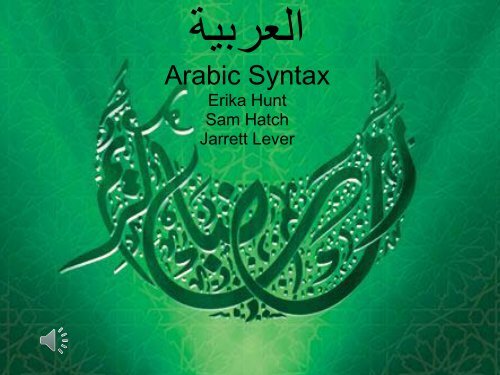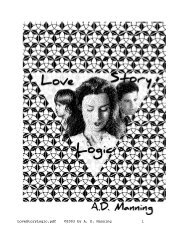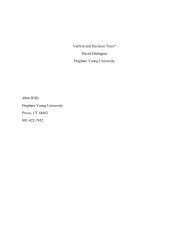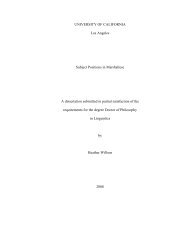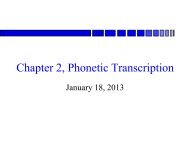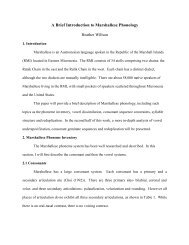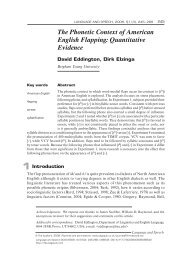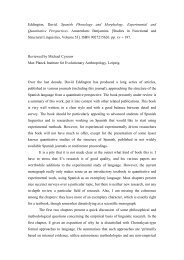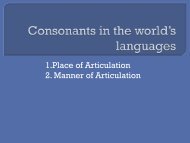Arabic Syntax - BYU Department of Linguistics and English Language
Arabic Syntax - BYU Department of Linguistics and English Language
Arabic Syntax - BYU Department of Linguistics and English Language
Create successful ePaper yourself
Turn your PDF publications into a flip-book with our unique Google optimized e-Paper software.
العربية<br />
<strong>Arabic</strong> <strong>Syntax</strong><br />
Erika Hunt<br />
Sam Hatch<br />
Jarrett Lever
About <strong>Arabic</strong><br />
• 206,000,000 L1 speakers <strong>of</strong> all <strong>Arabic</strong> varieties (ethnologue)<br />
• We will discuss Modern St<strong>and</strong>ard <strong>Arabic</strong> (Fusah)<br />
• Some places that it's spoken: Middle East, North Africa. Also in Algeria, Bahrain,<br />
Chad, Comoros, Djibouti, Egypt, Eritrea, Iraq, Israel, Jordan, Kuwait, Lebanon,<br />
Libya, Morocco, Oman, Palestinian West Bank <strong>and</strong> Gaza, Qatar, Somalia, Sudan,<br />
Syria, Tanzania, Tunisia, United Arab Emirates, Yemen. (ethnologue)<br />
• Script reads right to left
Overview<br />
• Word Order VSO or not VSO…<br />
• Hierarchy <strong>of</strong> Projections<br />
• Basic Sentences<br />
• Negation<br />
• Interrogatives<br />
• ECM & Pro (not!)
VSO, or is it????<br />
• Case Marking allows virtually<br />
any word order<br />
• VSO <strong>and</strong> SVO most common<br />
• Most agree that <strong>Arabic</strong> is VSO<br />
• MSA (Fusah) mostly VSO<br />
• Egyptian mostly SVO<br />
zayd-un qabala amr-an (SVO)<br />
Zayd met Amr<br />
qabala zayd-un 'amr-an<br />
met Zayd Amr
Hierarchy <strong>of</strong> the DP<br />
DP>(Poss)>nP>NP<br />
with other postnominal modifiers such as (Numbers) <strong>and</strong><br />
(Quantifiers) possible as well
Hierarchy Continued<br />
FP > CP> AP> TP > (NEG) > vP > VP<br />
New Categories<br />
FP- is a functional projection (not CP) where an auxiliary can go<br />
AP- Aspect phrase
Verbless Sentence<br />
• In cases where the sentence is equational (ie.<br />
x is y) <strong>Arabic</strong> does not use a verb<br />
• 'ana taalib (I am a student)<br />
• Word order is always SO
Basic Sentence with a Verb<br />
6 Ways to Say Zayd met Amar (there are<br />
more)<br />
un: nominative<br />
• qabala zayd-un 'amr-an an: accusative<br />
• qabala amr-an zayd-un<br />
• zayd-un qabala amr-an<br />
• zayd-un amr-an qabala<br />
• amr-an qabala zayd-un<br />
• amr-an zayd-un qabala<br />
With case marking all word orders are grammatical<br />
in MSA
Negation<br />
A. laa ya-qra-u Zayd-un al-kitaab-a<br />
NegPresent IMPER-read 3sg.mas.-IND Zayd-NOM the-book-ACC<br />
“Zayd is not reading the book.”<br />
B. lam ya-qra-Ø Zayd-un al-kitaab-a<br />
NegPast IMPER-read 3sgmas-JUS Zayd-NOM the-book-ACC<br />
“Zayd did not read the book.”<br />
C. lan ya-qra-a Zayd-un al-kitaab-a<br />
NegFuture IMPER-read 3sgmas-SUB Zayd-NOM the-book-ACC<br />
“Zayd will not read the book."<br />
D. t-tullab-u laa ya- drus-uu-n<br />
the-students Neg 3-study-mp-ind<br />
"The students do not study"<br />
The negation particle laa in SA is tense-inflecting. Depending on the tense <strong>of</strong><br />
the sentence, it will surface as lam (for negation in the past), lan (for negation<br />
in the future), or laa, the elsewhere form
Negation Con. (in verbless sentences)<br />
A. maa Zayd-un fii-/al-dar-i<br />
Neg Zayd-NOM in-the-house-GEN<br />
“Zayd is not in the house.”<br />
b. laysa Zayd-un fii-/al-dar-i<br />
Neg3sg.mas. Zayd-NOM in-the-house-GEN<br />
“Zayd is not in the house.”<br />
c. *laa/lam/lan Zayd-un fii-/al-dar-i<br />
Neg Zayd-NOM in-the-house-GEN<br />
Laa, lam, <strong>and</strong> lan all carry tense information that is received from the verb <strong>of</strong> the<br />
sentence. If the sentence is verbless, maa or laysa is used.
Interrogatives: Wh-Questions<br />
• Wh-questions require a verb to follow the wh-element:<br />
o man 'akala at tuffahat-a<br />
o who ate(3sg Masc) the apple (acc)<br />
• However, embedded clauses in the question can follow<br />
whatever order they want, so long as a verb follows the wh<br />
o mada qalat<br />
muna ‘inna ‘ahmad-a ‘akala<br />
o what said(3sg fem) Mona that Ahmed-Acc ate (3 sg masc)<br />
• The wh-element moves up from comp-VP to spec-CP<br />
• Word order <strong>of</strong> embedded clauses shows that MSA is VSO<br />
o If <strong>Arabic</strong> is VSO, the wh-simply moves up the hierarchy from<br />
spec-CP to spec-CP without changing any word order<br />
o If <strong>Arabic</strong> is SVO, the wh- must move through each spec-CP <strong>and</strong><br />
then front the verb <strong>of</strong> the last clause it l<strong>and</strong>s in. Because the<br />
fronting does not apply to each clause, SVO is less logical than<br />
VSO
VSO<br />
Wh-sentence<br />
with<br />
embedded<br />
clause<br />
What did Mona say Ahmed<br />
ate?
Assignment <strong>of</strong> Case:<br />
CP & TP<br />
• CP <strong>and</strong> TP both assigning case to the “subject” DP <strong>of</strong> the<br />
clause<br />
• C <strong>and</strong> T with case features have to discharge them<br />
• The case feature that is explicitly realized is the case from<br />
the highest head in the tree.<br />
CP's case is realized on the "subject"<br />
TP's case is realized on the "subject"<br />
ʔaʕtaqidu ?anna l-walad-a fii l-bayt-i<br />
Believe.1.a. that the-child-ACC in the-house-GEN<br />
‘I believe that the child is in the house.’<br />
qultu ʔinnha-hu waSala l-ʔawlaad-u<br />
said.1.s. that-it arrived.3.m.s. the–children-NOM<br />
‘I said that the boys arrived’
A<br />
s<br />
o<br />
f<br />
s<br />
i<br />
g<br />
n<br />
C<br />
a<br />
s<br />
m e<br />
e :<br />
CP's Acc.Case is<br />
realized<br />
n<br />
t<br />
C<br />
&<br />
T<br />
TP's Nom.Case is realized
pro<br />
• verb w/ all <strong>of</strong> its inflection<br />
doesn't need a subject<br />
• Thus a lot <strong>of</strong> little pro in<br />
<strong>Arabic</strong><br />
• Called by some a "nullsubject<br />
language"
ECM<br />
• a "pseudo-ECM"<br />
o assigns accusative case to the embedded “subject”<br />
o yet there is a CP present<br />
o <strong>and</strong> the “verb” <strong>of</strong> the complementary phrase is not<br />
infinitival but is technically tensed*<br />
ʔaʕtaqidu ʔanna-hu ya-lʕabu<br />
Believe.1.s. that-him 3-playing<br />
‘I believe that he is playing’<br />
*though there may be no “independent temporal” interpreter <strong>of</strong> the action (see notes).
ECM continued<br />
ʔaʕtaqidu ʔanna-hu ya-lʕabu<br />
Believe.1.s. that-him 3-playing<br />
‘I believe that he is playing’
الأسئلة<br />
Questions?


